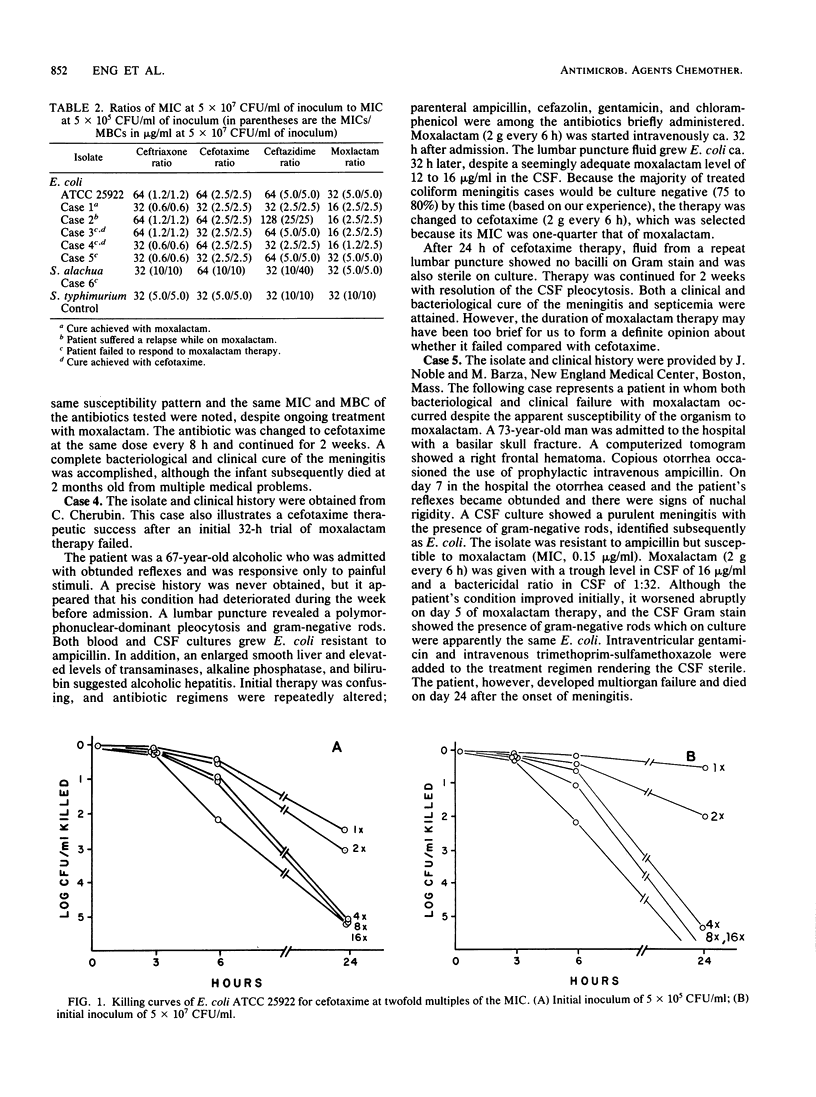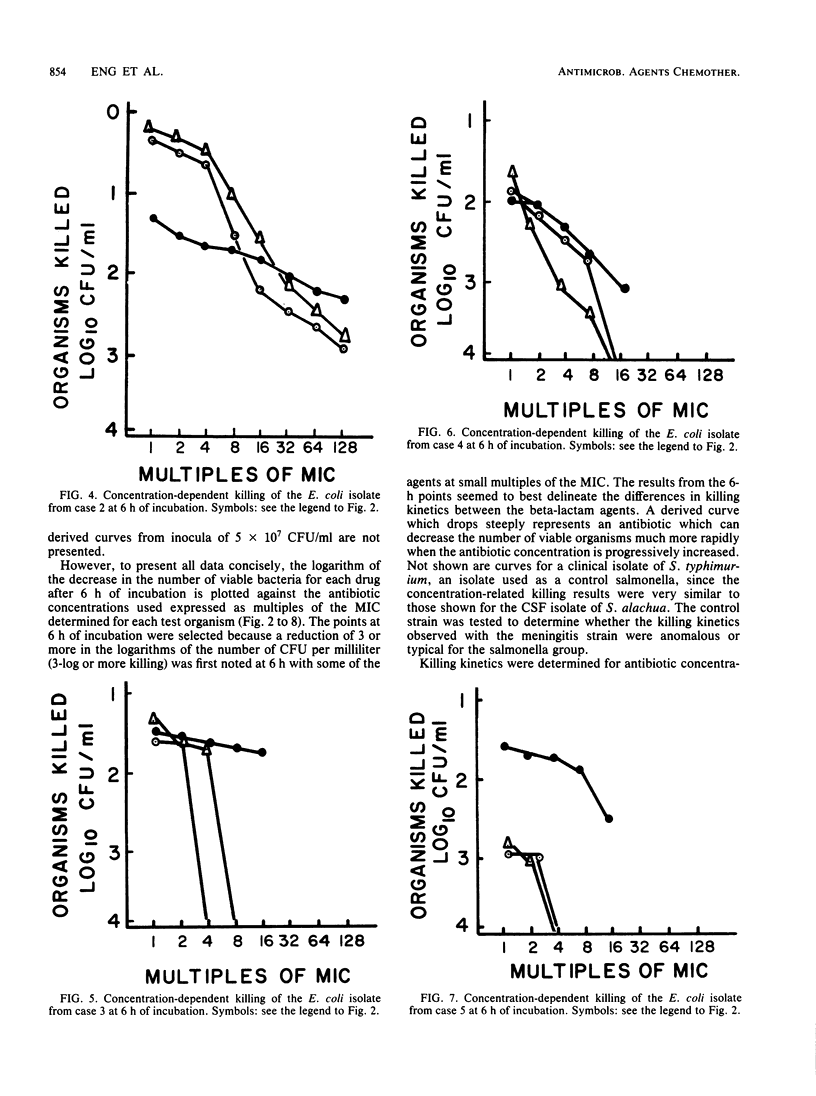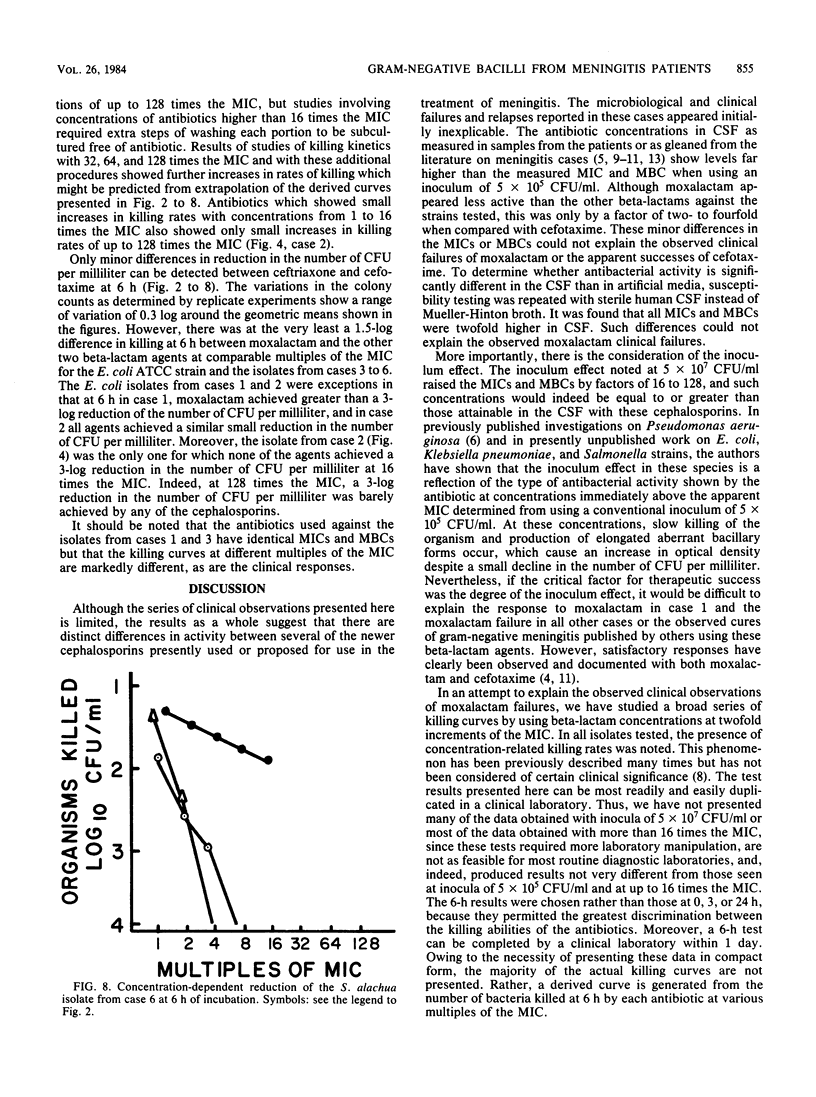Abstract
One Salmonella and four Escherichia coli isolates from patients with bacterial meningitis who had responded slowly, relapsed, or failed to respond to monotherapy with moxalactam were examined. For purposes of comparison, an E. coli isolate from one patient who had responded promptly to therapy was also studied. On testing, moxalactam had higher MICs and MBCs (two to four times) than cefotaxime or ceftriaxone for all isolates; the rates of killing of the isolates were dependent on the antibiotic concentrations used. At comparable multiples of the MIC, these isolates were generally killed more slowly by moxalactam than by cefotaxime or ceftriaxone. In addition, a reduction of 3 in the logarithm of the number of CFU per milliliter could be attained at far lower concentrations with cefotaxime or ceftriaxone than with moxalactam. The degree of concentration-related killing of bacteria produced by the beta-lactams appeared to correlate with the clinical responses of the patients. Furthermore, real differences appeared to exist among the third-generation cephalosporins, which were not evident by the MIC and MBC points alone but were evident in the concentration-related killing curves: Determination of a reduction of 3 in the logarithm of the number of CFU per milliliter after a 6-h incubation is suggested as the criterion for the screening of antibiotics for the therapy for gram-negative bacillary meningitis.
Full text
PDF






Selected References
These references are in PubMed. This may not be the complete list of references from this article.
- Bradsher R. W. Relapse of gram-negative bacillary meningitis after cefotaxime therapy. JAMA. 1982 Sep 10;248(10):1214–1215. [PubMed] [Google Scholar]
- Broughton R. A., Mason E. O., Baker C. J. Relapse of Escherichia coli meningitis following therapy with moxalactam. Pediatr Infect Dis. 1982 Jan-Feb;1(1):24–28. doi: 10.1097/00006454-198201000-00007. [DOI] [PubMed] [Google Scholar]
- Cherubin C. E., Corrado M. L., Nair S. R., Gombert M. E., Landesman S., Humbert G. Treatment of gram-negative bacillary meningitis: role of the new cephalosporin antibiotics. Rev Infect Dis. 1982 Sep-Oct;4 (Suppl):S453–S464. doi: 10.1093/clinids/4.supplement_2.s453. [DOI] [PubMed] [Google Scholar]
- Corrado M. L., Gombert M. E., Cherubin C. E. Designing appropriate therapy in the treatment of gram-negative bacillary meningitis. JAMA. 1982 Jul 2;248(1):71–74. [PubMed] [Google Scholar]
- Eng R. H., Smith S. M., Cherubin C. Inoculum effect of new beta-lactam antibiotics on Pseudomonas aeruginosa. Antimicrob Agents Chemother. 1984 Jul;26(1):42–47. doi: 10.1128/aac.26.1.42. [DOI] [PMC free article] [PubMed] [Google Scholar]
- Hayes M. V., Orr D. C. Mode of action of ceftazidime: affinity for the penicillin-binding proteins of Escherichia coli K12, Pseudomonas aeruginosa and Staphylococcus aureus. J Antimicrob Chemother. 1983 Aug;12(2):119–126. doi: 10.1093/jac/12.2.119. [DOI] [PubMed] [Google Scholar]
- Kaplan S. L., Mason E. O., Jr, Garcia H., Kvernland S. J., Loiselle E. M., Anderson D. C., Mintz A. A., Feigin R. D. Pharmacokinetics and cerebrospinal fluid penetration of moxalactam in children with bacterial meningitis. J Pediatr. 1981 Jan;98(1):152–157. doi: 10.1016/s0022-3476(81)80562-8. [DOI] [PubMed] [Google Scholar]
- Modai J., Wolff M., Lebas J., Meulemans A., Manuel C. Moxalactam penetration into cerebrospinal fluid in patients with bacterial meningitis. Antimicrob Agents Chemother. 1982 Apr;21(4):551–553. doi: 10.1128/aac.21.4.551. [DOI] [PMC free article] [PubMed] [Google Scholar]
- Rahal J. J., Jr Moxalactam therapy for gram-negative bacillary meningitis. Rev Infect Dis. 1982 Nov-Dec;4 (Suppl):S606–S609. doi: 10.1093/clinids/4.supplement_3.s606. [DOI] [PubMed] [Google Scholar]
- Salzer W., Pegram P. S., Jr, McCall C. E. Clinical evaluation of moxalactam: evidence of decreased efficacy in gram-positive aerobic infections. Antimicrob Agents Chemother. 1983 Apr;23(4):565–570. doi: 10.1128/aac.23.4.565. [DOI] [PMC free article] [PubMed] [Google Scholar]
- Schaad U. B., McCracken G. H., Jr, Threlkeld N., Thomas M. L. Clinical evaluation of a new broad-spectrum oxa-beta-lactam antibiotic, moxalactam, in neonates and infants. J Pediatr. 1981 Jan;98(1):129–136. doi: 10.1016/s0022-3476(81)80559-8. [DOI] [PubMed] [Google Scholar]


